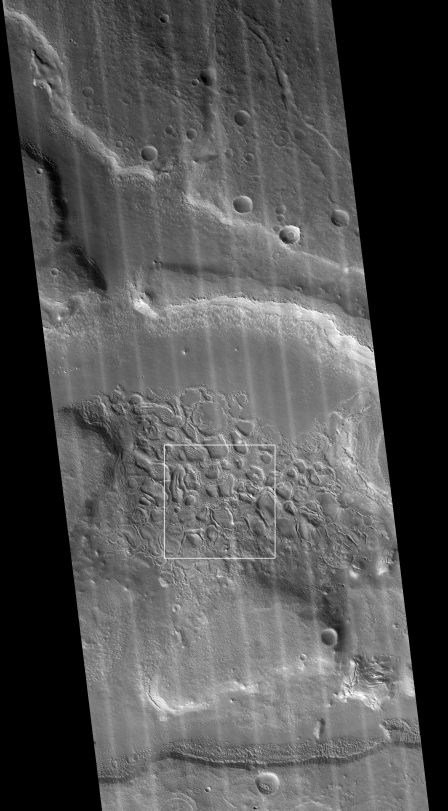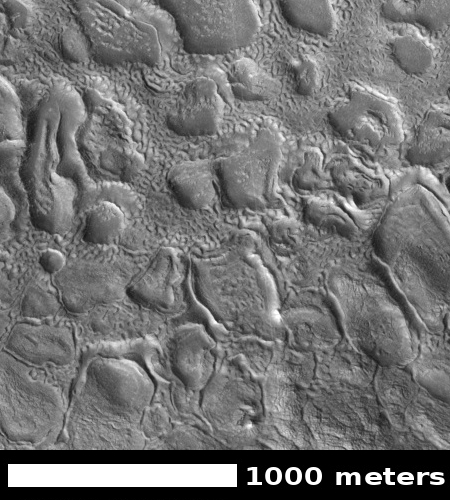Honeycombs on Mars
Cool image time! The image on the right, cropped to post here, came from the October 3, 2018 image release from the high resolution camera on Mars Reconnaissance Orbiter (MRO). It shows what the science team labels “honeycomb shapes in Ismeniae Fossae.” If you click on the image you can see the full picture.
This particular image does not include a caption so don’t ask me how this feature formed, as I really haven’t the faintest theory, and the MRO science team didn’t provide me one.
It is clear that dust has gathered in small dunes within these honeycombs. That provides no help, however, as the larger honeycombs are surrounded on their ridges by complex smaller ridge patterns that remind me vaguely either of rimstone dams in caves, or of the doodles you might draw during a boring class.

Increasing the mystery is the location of this feature. The image to the right, annotated to indicate where the insert above is located, shows that the honeycombs are formed at the bottom of what looks like a valley or shallow gorge. The full image emphasizes this, as the terrain to the north and south is a flat plateau above that valley.
That the honeycombs only occur in one small area on that valley floor further deepens the mystery. Unfortunately, MRO has not taken a lot of high resolution images of this area, which is located on the rough plateau region that drains down into the lower northern plains at 39.7 degrees north latitude and 39.9 degrees east longitude. MRO’s wide field camera has covered the area thoroughly, however, revealing it to be a very fractured and complex terrain with many criss-crossing ravines generally draining to the north and east into the northern plains. Scattered throughout this area are many other strange features not that dissimilar from the honeycombs, though not yet photographed at high resolution.
I must emphasize that the drainage path is not that clear, and almost seems chaotic, as if the water, instead of flowing downhill toward the plains, mostly seeped downward through the ground in an almost random pattern, dissolving the gorges because these were fracture or fault zones that were easily eroded.
Why these honeycombs should exist still remains baffling. Maybe they are features of a more resistance material, but if so, that still does not explain their strange shapes.
This is where I will leave this. Mars is wonderfully strange. It will be a fascinating experience to walk on its surface and see it up close.
On Christmas Eve 1968 three Americans became the first humans to visit another world. What they did to celebrate was unexpected and profound, and will be remembered throughout all human history. Genesis: the Story of Apollo 8, Robert Zimmerman's classic history of humanity's first journey to another world, tells that story, and it is now available as both an ebook and an audiobook, both with a foreword by Valerie Anders and a new introduction by Robert Zimmerman.
The print edition can be purchased at Amazon or from any other book seller. If you want an autographed copy the price is $60 for the hardback and $45 for the paperback, plus $8 shipping for each. Go here for purchasing details. The ebook is available everywhere for $5.99 (before discount) at amazon, or direct from my ebook publisher, ebookit. If you buy it from ebookit you don't support the big tech companies and the author gets a bigger cut much sooner.
The audiobook is also available at all these vendors, and is also free with a 30-day trial membership to Audible.
"Not simply about one mission, [Genesis] is also the history of America's quest for the moon... Zimmerman has done a masterful job of tying disparate events together into a solid account of one of America's greatest human triumphs."--San Antonio Express-News
Cool image time! The image on the right, cropped to post here, came from the October 3, 2018 image release from the high resolution camera on Mars Reconnaissance Orbiter (MRO). It shows what the science team labels “honeycomb shapes in Ismeniae Fossae.” If you click on the image you can see the full picture.
This particular image does not include a caption so don’t ask me how this feature formed, as I really haven’t the faintest theory, and the MRO science team didn’t provide me one.
It is clear that dust has gathered in small dunes within these honeycombs. That provides no help, however, as the larger honeycombs are surrounded on their ridges by complex smaller ridge patterns that remind me vaguely either of rimstone dams in caves, or of the doodles you might draw during a boring class.

Increasing the mystery is the location of this feature. The image to the right, annotated to indicate where the insert above is located, shows that the honeycombs are formed at the bottom of what looks like a valley or shallow gorge. The full image emphasizes this, as the terrain to the north and south is a flat plateau above that valley.
That the honeycombs only occur in one small area on that valley floor further deepens the mystery. Unfortunately, MRO has not taken a lot of high resolution images of this area, which is located on the rough plateau region that drains down into the lower northern plains at 39.7 degrees north latitude and 39.9 degrees east longitude. MRO’s wide field camera has covered the area thoroughly, however, revealing it to be a very fractured and complex terrain with many criss-crossing ravines generally draining to the north and east into the northern plains. Scattered throughout this area are many other strange features not that dissimilar from the honeycombs, though not yet photographed at high resolution.
I must emphasize that the drainage path is not that clear, and almost seems chaotic, as if the water, instead of flowing downhill toward the plains, mostly seeped downward through the ground in an almost random pattern, dissolving the gorges because these were fracture or fault zones that were easily eroded.
Why these honeycombs should exist still remains baffling. Maybe they are features of a more resistance material, but if so, that still does not explain their strange shapes.
This is where I will leave this. Mars is wonderfully strange. It will be a fascinating experience to walk on its surface and see it up close.
On Christmas Eve 1968 three Americans became the first humans to visit another world. What they did to celebrate was unexpected and profound, and will be remembered throughout all human history. Genesis: the Story of Apollo 8, Robert Zimmerman's classic history of humanity's first journey to another world, tells that story, and it is now available as both an ebook and an audiobook, both with a foreword by Valerie Anders and a new introduction by Robert Zimmerman.
The print edition can be purchased at Amazon or from any other book seller. If you want an autographed copy the price is $60 for the hardback and $45 for the paperback, plus $8 shipping for each. Go here for purchasing details. The ebook is available everywhere for $5.99 (before discount) at amazon, or direct from my ebook publisher, ebookit. If you buy it from ebookit you don't support the big tech companies and the author gets a bigger cut much sooner.
The audiobook is also available at all these vendors, and is also free with a 30-day trial membership to Audible.
"Not simply about one mission, [Genesis] is also the history of America's quest for the moon... Zimmerman has done a masterful job of tying disparate events together into a solid account of one of America's greatest human triumphs."--San Antonio Express-News



Well, Sit Fiducit that the Pareidolia crowd we be along shortly to “Identify” the objects as animals of some kind, or something similar….I hear Ricky Hoaxland and Mike Bara now……”More proof that NASA is covering up important proof of…..”